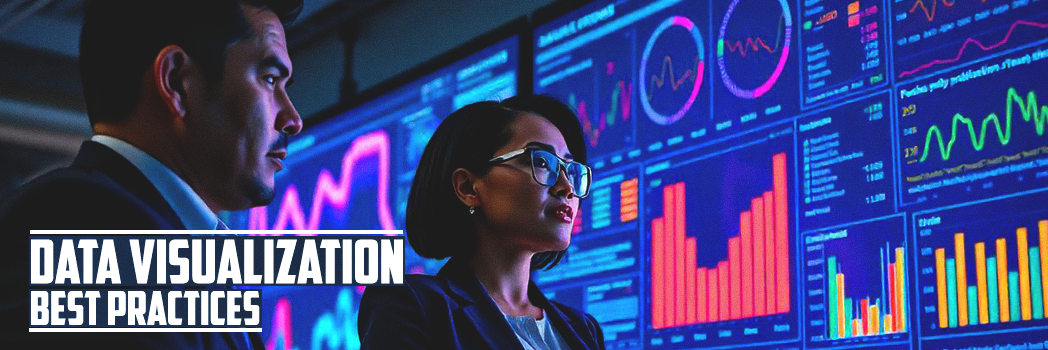Data visualization techniques are the knack and science of showcasing data sets in a clear and compelling visual format. All kinds of data sets, whether structured or unstructured, complex or simple, contain valuable information about the organization’s functionalities.
This information helps strategize sales methods, mitigate losses, develop marketing plans, develop customer retention plans, and more. While visualization can powerfully communicate insights, poor design can lead to confusion or misinterpretation. Religious accompanying best practices ensure that the data visualization is effective and eye-catching.
Data Visualization Tips
1. Explaining Your Objectives
Before proceeding to the design of effective data visualization, it is vital to evaluate the motive behind it. The data analyst also needs to find what message they need to fetch, the audience they are catering to and what decisions will this visualization inform.
For better understanding let’s take an example, visualization for a technical audience can be incorporated with more detailed data sets, while those for the executive level should focus on high-level insights.
2. Select The Right Chart Type
The diverse kinds of data types and relationship demands specific chart types. It is crucial to assess the chat types that coincide with the data story you want to depict. Experts should also avoid combining too many chart types and complicating it.
- Bar Charts- This visual data analysis is ideal for comparisons.
- Line Charts- These represent the best trends over some time.
- Pie Charts- To explain certain business aspects out of the entire, the pie charts are used.
- Scatter Plots- These representations are excellent for displaying relationships and distributions.
- HeatMaps- These chart types are mandatory for visualizing the intensity across two variables.
3. Simplify and Emphasize
This point explains if the goal of a bar chart is to display a significant increase in sales, then experts should highlight the specific bar in a contrasting color.
- Eliminate Clutter- The data analysts should prevent unwanted elements such as excessive gridlines, 3D effects, and needless labels.
- Highlight Key Insights- Always use color, bold texts, annotations, etc to pull the attention towards the crucial information.
- Diminish Distractions- Keep fonts simple and use neutral backgrounds.
4. Effective Colour Application
The data analysts should refrain from using colors that do not coincide with the data story or confuse the viewer. Colors can improve or divert your focus from the visualization.
- Restrict Your Pallete- Always stick to a 5 to 7-color palette.
- Be Mindful of Accessibility- Consider the colorblind people and choose tools like ColorBrewer, so that they can understand the visualizations.
- Communicate Meaning- Apply colors to segment, focus, or differentiate ( for example: red for negative trends, green for growth, etc.)
5. Label Clearly and Precisely
Labels help in understanding the context and variables present in the graphs or diagrams.
- Always Use Descriptive Titles- In this part, you need to describe a little about the visualization.
- Incorporate Axis Labels- Specify units and metrics like sales in USD or growth rate in %.
- Prevent Labeling- It should only comprise essential data points to maintain readability.
6. Conserve Proportionality
Your visuals should precisely depict the data obtained. Thus analysts should
- Avoid Distorted Axes- Beginning the bar chart at zero point can mislead the audience.
- Respect Area Proportionality- Especially in bubble charts or maps, ensure the major areas reflect proportionately higher values.
For instance, dilating the size of a pie slice can depict false information to the audience.
7. Prioritize Readability
Your audience should grasp the visual data analysis rapidly.
- Font Size- Implement readable font size for all text elements.
- Alignment- Coincide text and visuals for a clean and professional appearance.
- Legend and Keys- Locate them logically (for example- near the corresponding data sets)
8. Give Context
Without context, data can be misleading
- Include Baselines- Showcase past trends or averages for comparison.
- Use Annotations- Incorporate notes or makers to elucidate anomalies or trends.
- Add Reference Points- Indicate targets or thresholds when applicable.
For example, a line chart that monitors quarterly revenue could include a horizontal line for the revenue aim.
9. Test Your Visualization
Before displaying your data visualizations, test its effectiveness.
- Seek Feedback- You can share the prepared analysis report with your fellow workers to ensure effective readability. This helps in securing clarity of the data visualization.
- Cross-check Accuracy- Double verify the calculations, and labels to prevent errors.
- Assess Clarity- Evaluate whether the visualization communicates the intended messages rapidly.
10. Consider Your Audience
Your audience qualification background should be behind the layout of your data visualization. For executives focus on conclusions and actionable insights.
For analysts, add detailed data and numerous perspectives. And, for general audiences, simplify complex metrics and avoid jargon.
11. Data Storytelling
Visualizations are more promising when they portray a logical story.
- Organize Your Narratives- Start with the contexts, highlight key insights, and summarize their impact.
- Join Visuals- Make sure all elements coincide perfectly to tell a collaborative story.
- Avoid Data Dumping- Emphasize the story behind the numbers, more than your audience with raw data sets.
12. Best Tools for Data Visualization
Implement modern data visualization tools for data visualization best practices.
- Spreadsheets Tools- Excel, Google Sheets for basic chart style portrayal.
- Visualization Software- PowerBI, Tableau, and Looker for interactive and advanced data visualization.
- Programming Libraries- Matplotlib, Seaborn, Plotly (Python), or ggplot2 (R) for custom visualizations.
Conclusion
Generating impactful data visualizations involves using data visualization tools and executing best practices through them. These tools help to develop attractive visuals communicate insights and engage the audience.
Data visualization helps in effective storytelling and decision-making. Opting for such tools enhances your career prospects and creates exciting opportunities to flourish in the global job market.
